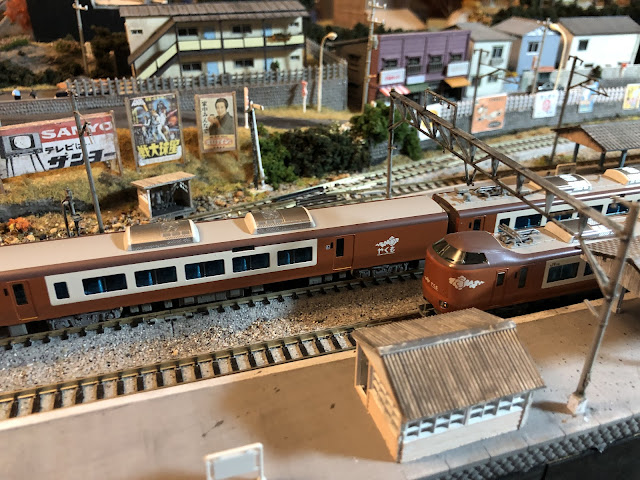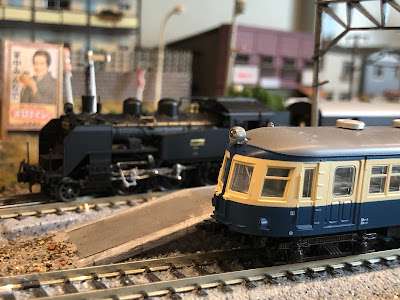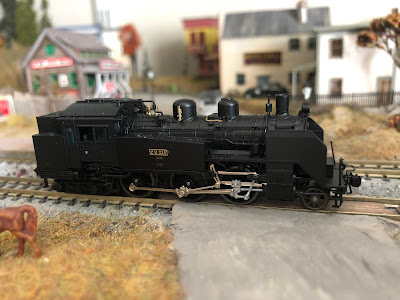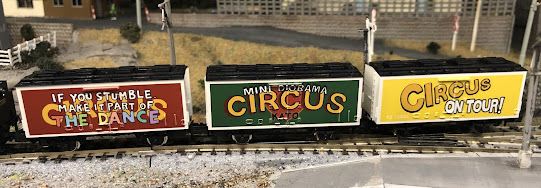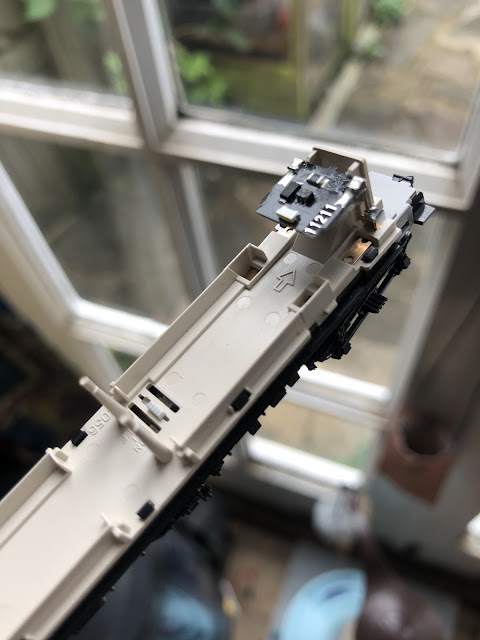This isn't just a new release from Kato, but a new train on Japanese Railways. Released in March, 2025, Kato have produced two versions, a 4-car starter pack (20,350 Yen) and an 8-car special edition (38,500 Yen) in a slip case.
Background
The 273-series 'Yakumo' is one of JRWest's newest trains. Operating between Okayama (on the San'in Main Line) and Izumo (on the Hakubi Line) the route passes through numerous towns as well as famously beautiful scenery. However, earlier generations of rolling stock had a reputation for being a bit shaky and uncomfortable. So, the new 'Yakumo' trains were designed, therefore, to be much more smooth as well as fast. The big, comfy seats can be rotated so that they can either be airplane-style or face-to-face for groups traveling together, and the bathrooms are spacious enough for people in wheelchairs to use easily.
Mechanically, these are tilting trains (something the Kato model replicates) with a maximum speed of 120 km/h (about 75 mph) that operate on 1500V DC. Their livery is unique, a sort of coppery-brown with cream around the windows and a distinctive white cloud design on the sides and cab ends that represents the 'Yakumo' branding.
Kato Class 273-series 'Yakumo' (10-1999)
What's in the box?
- One powered car and three unpowered cars
- Accessory pack including replacement one pair of folding doors and a single gangway piece
- Sticker sheet including destination signs
- Class 273 information booklet
- Instruction leaflet
Described as the Starter Pack version of the train, at 20,350 Yen this is also the cheaper of the two 'Yakumo' trains produced by Kato. It is presented in the cardboard box and expanded polystyrene tray as their other budget offerings, such as the freight car starter pack and the old-style passenger train pack. So, it's easy to store this train pack alongside those on the same shelf.
The cars need to be pushed together on the rail for the couplers to engage with a 'click'. Once that's done off the train goes! Performance is excellent thanks to its slot-less motor, pretty much what you'd expect from any modern Kato train. Cab-end lights come on with minimal current and stay uniformly bright as the train accelerates smoothly.
Externally, the models match our expectations from Kato. The paintwork and printing is excellent, though there has been some discussion as to how effectively the paint on the model matches the glossy, even metallic, finish seen on the real trains. I'm on the fence on this one. When we're looking at model trains on a layout, every 30 cm we stand away from the model is 45 m in the real world, and colours look different as distance increases.
Described as the Starter Pack version of the train, at 20,350 Yen this is also the cheaper of the two 'Yakumo' trains produced by Kato. It is presented in the cardboard box and expanded polystyrene tray as their other budget offerings, such as the freight car starter pack and the old-style passenger train pack. So, it's easy to store this train pack alongside those on the same shelf.
The cars need to be pushed together on the rail for the couplers to engage with a 'click'. Once that's done off the train goes! Performance is excellent thanks to its slot-less motor, pretty much what you'd expect from any modern Kato train. Cab-end lights come on with minimal current and stay uniformly bright as the train accelerates smoothly.
Externally, the models match our expectations from Kato. The paintwork and printing is excellent, though there has been some discussion as to how effectively the paint on the model matches the glossy, even metallic, finish seen on the real trains. I'm on the fence on this one. When we're looking at model trains on a layout, every 30 cm we stand away from the model is 45 m in the real world, and colours look different as distance increases.
Otherwise, these are nice trains. As is often the case with Kato trains, there are a couple of upgrades available using optional parts available from the usual suppliers. For a start, there's the addition of interior lighting, for which Kato recommend the 'warm white' lighting kits. You'll need at least four of the single-piece pack (#11-213) for a four-car set, although the 6-piece pack (#11-214) is better value if you can use the two spare lighting kits on other trains.
The other upgrade uses #28-220 to replace the lighting boards for the headlights at the cab ends. On the real trains, when two units are coupled together, the headlights of the two cabs that face each other stay illuminated, regardless of speed or direction of travel. This is a safety feature apparently, lighting up the area around the platform where the streamlined cab ends create a gap where somebody could fall into. I've not tried out this upgrade, but there's a nice overview on another blog, here.
According to the instruction leaflet, the set can be made DCC-compatible using #29-351 for the motor, #29-352 for the head/tail lights, and #29-353 for the interior lighting (if installed). These are replacement circuit boards for the analogue boards already fitted.
Otherwise, these are nice trains. As is often the case with Kato trains, there are a couple of upgrades available using optional parts available from the usual suppliers. For a start, there's the addition of interior lighting, for which Kato recommend the 'warm white' lighting kits. You'll need at least four of the single-piece pack (#11-213) for a four-car set, although the 6-piece pack (#11-214) is better value if you can use the two spare lighting kits on other trains.
The other upgrade uses #28-220 to replace the lighting boards for the headlights at the cab ends. On the real trains, when two units are coupled together, the headlights of the two cabs that face each other stay illuminated, regardless of speed or direction of travel. This is a safety feature apparently, lighting up the area around the platform where the streamlined cab ends create a gap where somebody could fall into. I've not tried out this upgrade, but there's a nice overview on another blog, here.
According to the instruction leaflet, the set can be made DCC-compatible using #29-351 for the motor, #29-352 for the head/tail lights, and #29-353 for the interior lighting (if installed). These are replacement circuit boards for the analogue boards already fitted.
Kato Class 273-series 'Yakumo' (10-2000)
What's in the box?
- One powered car and seven unpowered cars
- Accessory pack including replacement two pairs of folding doors and a two gangway piece
- Sticker sheet including destination signs
- Some sort of screwdriver-like tool, perhaps for switching on/off the headlights
- Class 273 information booklet
- Instruction leaflet
Although basically similar to the 4-car Starter Pack, I found the 8-car train a bit more problematic. Livery and performance are the same, but the lack of English-language instructions caused some initial frustration!
For a start, two of the cab units have non-working couplings. These look like small, grey, L-shaped pieces of plastic. They (and the grey pockets they clip into) can be removed and replaced with standard couplings and pockets, but since the 'Yakumo' only operates as 4-, 8-, and 12-car trains, there's no real point to doing so: just make sure these driving cars are at the ends of your train.
The other two cab units are the ones with working couplings seating in black pockets. However, as supplied the coupling is recessed slightly so its doesn't flop about when used as 'dummy' couplings at the end of a 4-car train. So, you need to slide the pocket forwards to release the coupling, which now becomes longer and much more flexible. If you don't do this, the trains will couple up just fine, but as soon as the train hits a curve it'll derail because the couplings don't move.
Apparently, this approach is not uncommon on Kato trains, but I'd not come across it before. Well, 'today I learned', as they say!
Once this hurdle had been overcome, I still found the train derailing, though this time only at one particular spot. It turned out that one of the snowploughs kept catching on a piece of rail. In fairness, this was at a joint between two boards, so the railhead might well have been fractionally out of line. But none of the snowploughs on the other 'Yakumo' units caught themselves here. Odd.
There may be an issue with the moulding of these pieces, as similar observations have been commented on, here and here. As it happens, the fix was easy. The bogie unclips and that allows the snowplough to be detached easily. A few strokes with a file reduced the thickness of the snowplough, and when it was put back into place and the train reassembled, it ran flawlessly.
The photo below shows the underside of one of these cars: the coupler can be seen as well as the wedge-shaped snowplough and the headlight switch.
Unlike the 4-car pack, the 8-car pack only includes two driving cars with through doors (or, at least, the open doors and gangways needed to replicate them). The other two driving cars cannot be adapted in this way, and furthermore, are fitted with non-functional (but more prototypical) couplings. This means that these two driving cars must always be at the ends of the train, whether it's being operated as a 4-, 8-, or 12-car unit. So, if you choose to combined this train pack with #10-1999 to create a 12-car unit, the four cars from #10-1999 need to be sandwiched in between the two 4-car units in #10-2000.
Fitting the gangways isn't too difficult but the replacement doors are very thin and easily snapped -- please don't ask me how I know! You start by removing the body shell from the chassis, then gently sliding out the cab detailing part. The piece of plastic that forms the sealed doors unclips and falls out the front, revealing a space into which the corridor connection clips. The whole process takes 5-10 minutes, and as you can see from the picture above, looks quite good despite the inevitable gap between the two cars.
Conclusion
Despite one or two mishaps along the way, once the couplers were sorted and the snowplough fixed, the train ran beautifully.
Detailing is mostly moulded, as is typical with Kato, but there are some separately fitted details worth noting beyond the doors and gangways already mentioned, such as the pantographs. There are no fewer than four of these on each 4-car unit! All can be raised and lowered as needed. As far as I can tell, only two are normally used on the real things at any one time.
There's a Kato Sound Card for the 'Yakumo' train that includes a number of authentic sounds to add to your driving experience. The card has both controller priority mode and sound synchronisation modes. In controller priority mode, you drive the train as normal, and the Sound Box reacts to things like curves and gradients automatically, for example, by having the motors 'whine' more as they work harder. In sound synchronisation mode the train speeds up and slows down more realistically, and the Sound Box plays the appropriate sounds (such as brakes and motors) as it does so. There are three horns available, one of which has a nifty Doppler effect which works nicely when the train is zipping past you.

